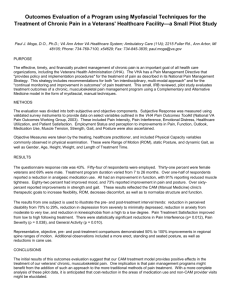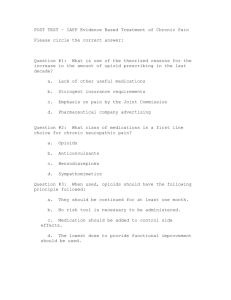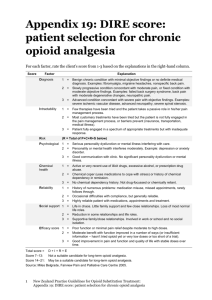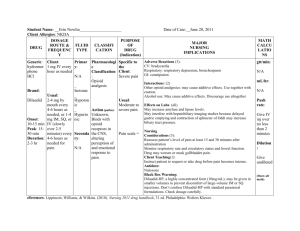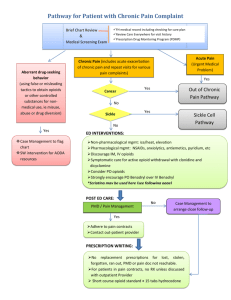Operation Enduring Freedom/Operation I i F d
advertisement
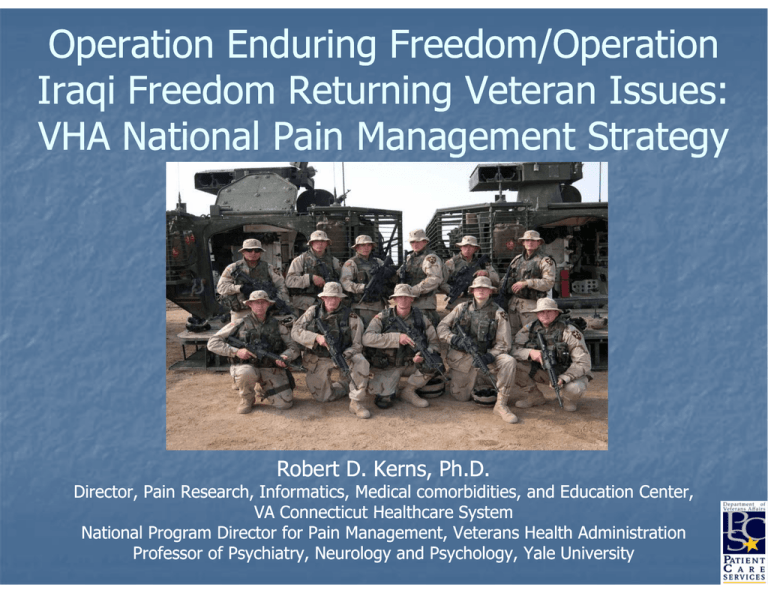
Operation Enduring Freedom/Operation I i Freedom Iraqi F d Returning R t i Veteran V t Issues: I VHA National Pain Management g Strategy gy Robert D. Kerns, Ph.D. Director, Pain Research, Informatics, Medical comorbidities, and Education Center, VA Connecticut Healthcare System National Program Director for Pain Management, Veterans Health Administration Professor of Psychiatry, Neurology and Psychology, Yale University VHA National Pain Management Strategy gy Objective is to develop a comprehensive, comprehensive multicultural, integrated, system--wide system syste de approach app oac to pain management that reduces pain and suffering for veterans experiencing acute and chronic pain associated with a wide range of illnesses,, including g terminal illness. VHA National Pain Management g Strategy gy Research as a priority Pain Research Working Group Theme based cluster groups 600% increase in pain research portfolio since 2000 Special issues: Journal of Rehabilitation Research and Development Pain P i Medicine M di i Psychological Services Pain Research Summits (2007, 2009) Pain Research,, Informatics,, Medical comorbidities and Education (PRIME) Center Frequency of Possible Diagnoses Among OEF and OIF Veterans Diagnosis (Broad ICD ICD--9 Categories) (n = 400,304) Frequency * % Infectious and Parasitic Diseases (001(001-139) Malignant g Neoplasms p (140--208)) ((140 Benign Neoplasms (210 (210--239) Diseases of Endocrine/Nutritional/ Metabolic Systems (240(240-279) Diseases of Blood and Blood Forming Organs (280(280-289) Mental Disorders (290(290-319) Diseases of Nervous System/ Sense Organs (320 (320--389) Diseases of Circulatory System (390(390-459) Disease of Respiratory System (460(460-519) Disease of Digestive System (520(520-579) Diseases of Genitourinary System (580(580-629) Diseases off Skin S (680-709) (68009) Diseases of Musculoskeletal System/Connective System (710(710-739) Symptoms, Signs and Ill Defined Conditions (780(780-799) Injury/Poisonings (800(800-999) 49,272 3,988 , 17,274 93,028 9,677 178,483 146 611 146,611 68,295 83,771 129,656 44,812 67,384 6 38 197,078 167,959 92,023 12.3 1.0 4.3 23.2 2.4 44.6 36 36.6 6 17.1 20.9 20.9 32.4 11.2 16 16.8 8 49.2 49.2 42.0 23.0 *These are cumulative data since FY 2002, with data on h hospitalizations ospitalizations and outpatient visits as of September 30, 2008; veterans can have multiple diagnoses with each healthcare encounter. A veteran is counted only once in any single diagnostic category but can be counted in multiple categories, so the above numbers add up to greater than 400,304. Cumulative thru 4th Quarter FY2008 Pain Assessment and Pain Characteristics byy Sex Female n=18,481 Male n=134,731 P value Pain Assessment 60.1% 59.6% 0.247 Any pain 38.1% 44.0% <0.0001 Moderate pain 68.0% 62.6% <0.0001 Persistent pain 18.0% 21.2% <0.0001 Haskell SG, Brandt C, Krebs EE, Skanderson M, Kerns R, Goulet JL. JL Pain among Veterans of Operations Enduring Freedom and Iraqi Freedom: Do Women and Men Differ? Pain Med. 2009 Oct;10(7):1167-73. Prevalence of Chronic Pain, PTSD and TBI in a sample of 340 OEF/OIF veterans Chronic Pain N=277 81 5% 81.5% 16.5% 10.3% 2.9% PTSD N=232 68.2% 42.1% 12.6% TBI N=227 66.8% 6.8% 5.3% Lew et al., (2009). Prevalence of Chronic Pain, Posttraumatic Stress Disorder and Post-concussive Symptoms in OEF/OIF Veterans: The Polytrauma Clinical Triad. Journal of Rehabilitation Research and Development, 46, 697-702. VA Stepped Pain Care RISK RISK Advanced diagnostics & interventions CARF accredited pain rehabilitation STEP 3 Comorbidities Treatment Refractory Complexity Pain Medicine Rehabilitation Medicine Behavioral Pain Management Multidisciplinary Pain Clinics SUD Programs Mental Health Programs Routine screening for presence & intensity of pain Comprehensive pain assessment Management of common pain conditions Support from MH-PC Integration, OEF/OIF, & Post Deployment Teams Post-Deployment Expanded care management Opioid Renewal Clinics STEP 2 STEP 1 Donaghue/Mayday Donaghue/Mayday Program g for Research Leadership p Study Tasks Intervention Development Implementing a VA SCM-PM Studyy Goal: To studyy the adoption p and implementation p of SCM-PM at VACHS and disseminate findings nationally Study Aim 1: To evaluate the implementation of the SCM-PM at VACHS using qualitative and quantitative methods (process). (process) Aim 1a: To evaluate implementation of SCM-PM through documentation of changes in pain management policies and procedures. Aim 1b: To evaluate the experience of organizational change and acceptability of the new model to VACHS pain management providers through qualitative interviews and organizational assessments. Study Aim 2: To test the effectiveness of the SCM SCM-PM PM at VACHS Retrospective Baseline Assessment Phase 1 SCM step 1: Primary Care Phase 1 Evaluation/Dissemination Phase 2 SCM steps 2 & 3: secondary and tertiary consultation and referral services Phase 2 Evaluation/Dissemination Phase 3: Model integration and sustainability i bili Phase 3: Evaluation/Dissemination y Data Analysis Knowledge Uptake Processes Year 1 Year 2 Year 3 Year 4 Pain Management: Exploring Primary Care Providers Attitudes, Knowledge, and Practices Research questions: 1) What are primary care providers’ attitudes, beliefs, and knowledge about pain management? 2) Is I there th a relationship l ti hi between b t provider id characteristics, h t i ti knowledge k l d and d beliefs b li f regarding di pain management and their patterns of opioid use and adherence to practice guidelines Methods: mixed methods using survey tools and administrative data sets K Knowledge l d Provider demographics Beliefs/attitudes F Frequency off opioid i id use Cohort of pts with chronic pain Adherence to practice standards d d Pain scores Promoting safe and effective use of opioids p Opioid – High Alert Medication Initiative Opioid Renewal Clinic Collaborative Addiction and Pain (CAP) Program Opioid Decision Support System Chronic Opioid Therapy – Clinical Practice Guideline O Opioid d Therapy h Web b Course C Standardized Opioid Pain Care Agreement g ee e t Behavioral Health Lab: Clinical Process Veteran Identification Screens/ Direct referral Pain Education provided BHL Initial Assessment Provider Recommendations Referral to MHC or pain clinic Referral Management Care Management (&/or pain school) Pain, Depression, Anxiety, Alcohol misuse No treatment & Refusal of care Dobscha et al. Collaborative care for chronic pain in primary care. JAMA 2009;301:1242 2009;301:1242--1252. 1252 Assistance with Pain Treatment (APT) vs Treatment as Usual (TAU) 42 primary care clinicians/401 patients Measures: Roland Morris Disabilityy Questionnaire Chronic Pain Grade – Pain Intensity Patient Health Questionnaire - 9 APT: Clinician education Pt assessment, education & activation Symptom monitoring Feedback and recommendations Facilitation of specialty care Change from baseline to 12 mo f.u. 0 ‐1 RMDQ CPG‐ PI PHQ‐9 ‐2 ‐3 3 TAU ‐4 APT ‐5 SCAMP Trial Kroenke K, K Bair MJ MJ, Damush TM et al al. Optimized antidepressant treatment and pain selfself-management in primary care patients with depression and musculoskeletal pain: A randomized controlled trial. JAMA 2009;301:2099 2009;301:2099--2110. Intervention Usual Care SCL-20 Depressio on 2.5 2 1.5 1 0.5 0 Baseline 1 month 3 months 6 months 12 months Time Period Summary Pain-relevant research is a high priority for VHA (and DoD) Specific focus on ‘P3+’ P3+ comorbidities among OEF/OIF Veterans I l Implementation i and d formative f i evaluation l i of stepped pp pain p care model Thanks! robert.kerns@va.gov

